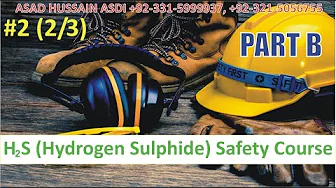IASP/ NASP Working from Height / Fall Protection Safety Course In Pakistan (Rawalpindi, Peshawar)
IASP/ NASP Working from Height / Fall Protection Safety Course
Working from heights poses significant risks to workers across various industries. Whether it's construction, maintenance, or industrial settings, falls remain one of the leading causes of workplace fatalities and injuries worldwide. Recognizing the importance of addressing this issue, the International Association of Safety Professionals (IASP) and the National Association of Safety Professionals (NASP) have collaborated to develop a specialized course focused on working from heights and fall protection safety.
In this comprehensive review, we will delve into the intricacies of the IASP/NASP Working from Height/Fall Protection Safety Course. From its inception to its potential impact on workplace safety, we will explore every aspect to provide a detailed understanding of this essential training program.
Course Introduction
The IASP/NASP Working from Height/Fall Protection Safety Course is designed to equip participants with the knowledge and skills necessary to mitigate risks associated with working at elevated positions. This course covers a wide range of topics, including regulatory requirements, hazard identification, fall prevention strategies, and rescue procedures.
Delivered through a combination of lectures, practical exercises, and case studies, the course ensures that participants gain a comprehensive understanding of fall protection principles and best practices. Whether you're a safety professional, a supervisor, or a worker exposed to height-related hazards, this course provides invaluable insights to enhance workplace safety.
Course Benefits
-
Enhanced Safety Awareness: By completing this course, participants develop a heightened awareness of potential hazards associated with working at heights, enabling them to identify and address risks proactively.
-
Regulatory Compliance: The course covers relevant regulations and standards, ensuring that participants are equipped to comply with legal requirements pertaining to fall protection and working from heights.
-
Risk Mitigation: Armed with knowledge about effective fall prevention strategies and control measures, participants can implement proactive measures to mitigate risks and prevent accidents.
-
Improved Skills: Practical exercises and simulations incorporated into the course help participants develop essential skills, such as the proper use of fall protection equipment and emergency response procedures.
-
Confidence and Competence: Upon completion of the course, participants gain confidence in their ability to work safely at heights and respond effectively to emergencies, fostering a culture of safety within their organizations.
Study Units
The IASP/NASP Working from Height/Fall Protection Safety Course comprises several study units, each focusing on key aspects of fall protection and safety at heights. These units include:
-
Introduction to Working from Height Safety: An overview of the course objectives, regulatory frameworks, and the importance of prioritizing safety when working at elevated positions.
-
Risk Assessment and Hazard Identification: Techniques for conducting comprehensive risk assessments and identifying potential hazards associated with working from heights, such as unprotected edges, unstable surfaces, and inadequate fall protection systems.
-
Fall Prevention and Protection Systems: In-depth exploration of various fall prevention and protection systems, including guardrails, safety nets, personal fall arrest systems (PFAS), and fall restraint systems.
-
Proper Use of Fall Protection Equipment: Hands-on training on the selection, inspection, and correct usage of fall protection equipment, including harnesses, lanyards, anchor points, and lifelines.
-
Emergency Response and Rescue Procedures: Strategies for responding to fall incidents, conducting rescue operations, and administering first aid to injured workers in a timely and efficient manner.
Learning Outcomes
Upon completing the IASP/NASP Working from Height/Fall Protection Safety Course, participants will:
-
Understand the regulatory requirements and industry standards relevant to working at heights and fall protection.
-
Identify potential hazards associated with working from heights and conduct effective risk assessments to mitigate risks.
-
Demonstrate proficiency in the selection, inspection, and proper use of fall protection equipment and systems.
-
Implement appropriate fall prevention measures and control strategies to enhance workplace safety.
-
Execute emergency response procedures and rescue operations effectively in the event of a fall incident.
Who is This Course For?
The IASP/NASP Working from Height/Fall Protection Safety Course is suitable for a wide range of professionals, including:
-
Safety Managers and Supervisors: Individuals responsible for overseeing safety programs and ensuring compliance with fall protection regulations within their organizations.
-
Construction Workers and Contractors: Personnel involved in construction, maintenance, and renovation projects where working at heights is a common occurrence.
-
Industrial Maintenance Technicians: Workers tasked with servicing and repairing equipment installed at elevated locations in industrial facilities.
-
Utility and Telecommunication Workers: Professionals engaged in installing, inspecting, and maintaining utility lines and telecommunications infrastructure at elevated heights.
-
Emergency Responders: Personnel involved in rescue operations and emergency medical services, requiring proficiency in fall rescue procedures and first aid.
Future Progression
Completion of the IASP/NASP Working from Height/Fall Protection Safety Course serves as a solid foundation for further professional development in the field of occupational safety and health. Participants may consider pursuing advanced certifications or specialized training programs to deepen their expertise in fall protection, such as:
-
Certified Fall Protection Specialist (CFPS) Certification: An advanced credential designed for safety professionals seeking expertise in the design, implementation, and management of fall protection programs.
-
Advanced Rigging and Rescue Techniques Courses: Specialized training programs focusing on advanced rigging techniques, high-angle rescue operations, and specialized rescue equipment usage.
-
Occupational Health and Safety (OHS) Diplomas or Degrees: Formal education programs offering comprehensive training in occupational safety and health management, including courses on fall protection, risk assessment, and regulatory compliance.
IASP/NASP Working from Height/Fall Protection Safety Course plays a pivotal role in enhancing workplace safety and reducing the incidence of falls and related injuries. By equipping participants with essential knowledge, skills, and best practices, this course empowers individuals to create safer working environments and protect lives at heights. Investing in comprehensive fall protection training is not only a legal obligation but also a moral imperative to ensure the well-being of workers in high-risk environments.
****** For Registration & Information ******
For Free Video Lectures Click Here











